 How to use miniature varnish - Miniature hobby guide
How to use miniature varnish - Miniature hobby guide
Article updated: 2021.02.11
I've gathered information about miniature varnish, and varnishing miniatures. If you'd like to know how to varnish miniatures, or what is the best varnish for miniatures, this is the varnishing guide you need.
Contents
Applying varnish on miniatures
Possible problems during varnishing
Frosting: How to prevent or fix frosting when you varnish miniatures
Stickiness: How to fix miniatures if the varnish remains sticky
Removing varnish from your miniatures
What is the best varnish for miniatures?
Questions - Varnishing miniatures
Resources - Miniature varnishing
What is varnish?
A varnish is a kind of protective medium that contains no pigment. When applied, it gives a transparent outer layer after drying.
A miniature varnish is a varnish that was created specifically to be used on small miniatures.
Varnish can change the look of the colours under it based on how transparent it will become, and can also change the reflectivity. If you add several layers of varnish, it increases the chance of changing the colours and it will also become more and more opaque. Some varnish can get "old", and after a few years or decades it can change in transparency or reflectivity (become yellow), and can crack.
Varnish types by sheen level
- Matte varnish: In several cases a product sold as matte varnish will still be slighty glossy, so try them before application.
- Satin shine varnish: Somewhere between matte and glossy.
- Glossy varnish: It will give a glossy finish. Unless you prefer glossy looking miniatures, I recommend buying pots instead of sprays, so you can brush the glossy varnish on the parts that need to be glossy. Some say glossy varnish gives a better protection than matte varnish.
Ultra-Violet protection
Some miniature varnishes offer UV protection to prevent fading of colours on your miniature due to sunlight. Unless you intend to display them in a gaming store, or store them in plain sunlight, you probably won't need it.
Differences between matte varnish and glossy varnish
As some people in the hobby use glossy varnish for better protection (and then adding matte varnish if you want to avoid the glossy look), I've asked the the chemist of the Pentacolor company about the kinds of varnishes. He said that while there should be no significant difference in most high quality, professional varnishes, there is still more acrylic medium in the same amount of fluid in a glossy varnish, and this is what gives protection. The amount of matting agent differs between different products, and this can cause different results. So if you really want to make a lasting varnish, he recommended glossy varnish.
There is another adventage of applying glossy varnish, then a layer of matte varnish to remove the shine, as when you see the miniature starts to shine, it means it needs another layer of matte varnish over the worn-out one.
Types of varnish by material
Acrylic medium: It is transparent, and also give a layer of protection to your miniatures after it dries. However, there are varnishes that can be removed from your miniature if it gets discoloured or starts to crack due to age, and you won't be able to remove an acrylic medium layer.
An acrylic medium can be diluted with water, but you could achieve faster drying with alcohol. After the acrylic medium dries, it becomes a solid resin layer that can be washed with water to clean it. Acylic medium is useful to use as a protective layer between layers of oil-based paints or paint effects, but it can be also used as a top layer.
Acrylic varnish: There are protective elements mixed into the acrylic medium. The more glossy the acrylic varnish is, the more protective it will become, as the matting agent takes away some of the protection.
Polyurethane medium: Similar to acrylic medium, but somewhat stronger. Polyurethane is useful as a top layer finish.
Polyurethane varnish: There are protective elements mixed into the polyurethane medium. Polyurethane varnish is more resistant than acrylic varnish. Some reviews say that it looks better on metallic colours than acrylic varnish.
Polymer varnish: It can be solved with alkaline solvents.
Cellulose varnish: It can be nitrocellulose or cellulose ester. It's more eco-friendly, as it is an organic polymer.
Chemical effects
There are some chemicals that can discolour, change the gloss or soften the miniature varnish. Try to keep them away from the finished miniature.
- Water: In polymer varnishes, 10-15 minutes in water can cause fogging, if the water is hot, it can cause sheen loss.
- Vinegar
- Oil
- Alcohol
- Isopropanol: It may remove the polymer varnish in 1 hour of soaking.
- Cleaning detergents
Uses for varnish
Layers to protect previous work
You can use a layer of varnish on your miniature to protect the paints you've painted on it. If you make a mistake on the new layer, it can help you remove the new paint.
- Acrylic paints: As you can wash the new paint off with water or alcohol that won't affect any dried layer, you don't really need the varnish.
- Oil-based paints: As you can only wash with a thinner, and it will solve any oil-based paint it touches, it might be useful to use a layer of varnish.
Waterslide decals
Some modellers recommend a layer of glossy varnish under waterslide decals.
For further information, see: How to apply waterslide decals on miniatures - Miniature hobby guide
Applying varnish on miniatures
Before you apply miniature varnish, make sure the paint is totally dry. Otherwise the paint can get mixed with the varnish and it can change the colour of the affected area, like a glaze. Unless you'd like to get this specific effect, be patient!
If you appy matte varnish over glossy varnish, wait for the glossy varnish to dry before you apply the matte one, because mixing the two can make the top look somewhat shiny.
How do you apply varnish to miniatures?
- Varnishing by brush: You can varnish the whole miniature or apply it on the spots that need varnish. Take care that a varnish might pool in recesses if it's not spread evenly. If it pools, after drying it won't be transparent, just translucent or white. Check your miniatures during the drying of the varnish, and spread it with your brush if the layer looks too thick. Depending on the varnish you use, you could thin it to get an even cover. Always read the instructions as some products are intended to be thinned before use.
- Varnishing by airbrush: The application is similar to spray varnish. Thinning depends on the product.
- Spray varnish: Spraying the varnish will give an even spread. However it's hard to apply spray on chosen spots if they are small. You might need a few run with the spray but avoid too much varnish as it could pool. To prevent health problems, always use spray varnish in a well ventillated area, preferably outdoors.
Varnishing in cold environment
In cold air, even a matte varnish can dry into a somewhat glossy look. To avoid this, the heated lamp method is a good solution.
Finishing seal / Top coat
After you finish painting your models, sometimes it's worth adding a finishing seal of miniature varnish to protect it. A plastic model painted with acrylic paint could last forever even without a finishing seal, if it's just standing on a display stand. Some varnish could change the look of the colours, and even if it's not apparent after drying, it can change with the age of the varnish in a few decades.
However, if you already have some good (preferably removable) varnish at home that you really trust, you could just varnish everything.
- Metal miniatures: Finishing seal will prevent paint chipping ott.
- Gaming miniatures: Finishing seal will protect them during rough handling.
- Miniatures with transfers: Finishing seal over the transfers will protect them from curling. I've heard that a glossy varnish under the transfer will help to stick it better to oil based enamels.
- Display cabinet miniatures: Use finishing seal at your own risk, unless its removable.
Applying the varnish
When you apply a layer of varnish, make sure it's even everywhere, and it doesn't pool in recesses. If needed, spread it with a wet brush or remove excess with a dry brush. If you put too much varnish on the miniature, it can create a thick layer that covers the detail. If you use highlight to show edges, it won't be that much of a problem. However, pooling can also cause the loss of transparency.
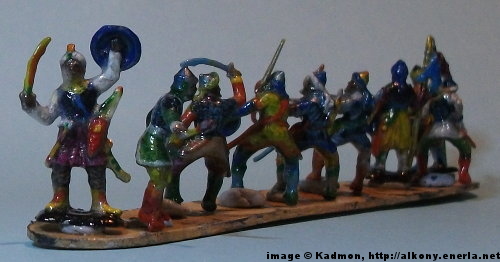 The effects of applying too much miniature varnish on your models
The effects of applying too much miniature varnish on your models
On the photo above you can see what can happen if you apply too much miniature varnish. I didn't thin the varnish because mounted miniatures get heavy use in our games as they are not glued on their mounts, and I thought it will get them more protection. I regret now this decision.
If you click on the image to enlarge it, it will be more apparent that the varnish created a layer of transparent plastic over every miniature, creating an even surface instead of the original, textured one. Also, I lost the face of the front miniature because of pooling. In the end I've repainted it to look like some mutant, or someone with a horrifying battle damage to his face.
The varnish I used on the above sample was labeled matte varnish. It's probably this glossy because it's too much on the miniatures. The same varnish (Pentart Matte Varnish) usually gives at most silk shine at the temperature I use it (around 20-25 Celsius).
Contrast paints and varnish
Contrast paints are created in a way that they make shadows where they pool, and highlights when they are thin over the white undercoat. This effect is achieved by semi-transparent paints. When you add matte varnish over the contrast paint, it can dull this effect.
Possible problems during varnishing
When you varnish your models, it might not comes out perfect in the end.
When tiny particles remain visible in the varnish, it's called frosting.
It can happen that the varnish remains sticky even after a long curing time.
Frosting: How to prevent or fix frosting when you varnish miniatures
A matte varnish consists of a liquid solvent and solid matting agents. If the solvent and the matting agent gets separated, the matting agent particles will remain visible. Even the best varnish for miniatures can become frosted in unsuitable circumstances.
Preventing frosting
- Humid environment: While drying, put the miniature in a dry environment. If there is too much moisture in the air, it can make the matte varnish look frosty. If you don't have a dry environment, put the miniature somewhere warm - for example under a table lamp with a classical light bulb that gives heat. Keep it there for at least 5-10 minutes, it will give it enough time for the varnish to not look frosty.
- Absorbent materials: If the coated material is absorbent, it can also cause a frosty look, because a the liquid medium of the varnish gets into the material, leaving the solid parts (the matting agent) outside. Before varnishing, cover them with a sealant layer.
- Brushing / airbrushing: You can mix the varnish with an acrylic or polyurethane medium. This can prevent frosting with some products.
How to fix frosting
If the varnish comes off frosty after drying, give the model another layer of varnish. The liquid varnish will encapsulate the solid material that gives the frosty look, and hopefully it will dry without frosting.
Stickiness: How to fix miniatures if the varnish remains sticky
Sometimes the varnish just needs more time to cure properly, but sometimes it will remain sticky no matter how long you wait. Sticky varnish can make your models stick together. If you cover your models with tissue paper when carrying them around, the paper can stick into the varnish. When you force the models apart, or when you pick the paper pieces, it can cause irregularities, damaging the look of the model.
Unless you can remove the varnish easily, I recommend another, thin layer of varnish over the sticky varnish. If that is not enough, you can probably give it up.
Sometimes it's the material of the model that affects the paint, and thus the stickiness. I've seen it happen with rubber-like materials and soft PVC.
I'm not sure about the cause, if you have a theory, please share it in the comments!
Removing varnish from your miniatures
Sometimes the miniature varnish gets discoloured, accumulates scratches or gets contaminated. It depends on the layers you've used if you can remove it.
If you use a polymer varnish with the intent of removing it in the future, you can apply a layer of acrylic medium (or any varnish that is not solved by alkaline), to act as an isolating layer. This way there will be an additional protective layer on the miniature under the polymer layer that can be removed if you wish.
- Acrylic medium or acrylic varnish: It won't come off easily.
- Polyurethane medium or polyurethane varnish: It won't come off easily.
- Polymer varnish: It can be solved with alkaline solvents (like ammonia). Try to get clear ammonia without any additional extras (fragrance, soap). Always use protective equipment (respirator, gloves, googles) and work in a well-ventillated ares (preferably outdoors).
* * *
What is the best varnish for miniatures?
I've created a list of miniature varnish products recommended by painters. I didn't use most of these, but I trust the opinion of others.
Acrylic medium (water soluable)
Although it's not a varnish, it can still provide protection to a painted miniature.
- Recommended products
- Games Workshop - Citadel Technical - Lahmian Medium
- Liquitex - Matte Medium
- Tamiya - Acrylic X-21 Flat Base: It is an mattening additive to Tamiya Color paints, but some recommend to use it.
- Testors - Model Master - Flat Clear Acrylic
Matte varnish
A matte varnish is a varnish that gives a matte finish.
- Recommended products
- Army Painter - Anti Shine: It's transparent even when liquid, so it won't dry opaque even when it pools.
- Daler Rowney - Soluable Matt Varnish: 4 part varnish, 1 part white spirit with airbrush
- Galeria - Matt Varnish
- Games Workshop - Matt Varnish
- Rustoleum - Clear Coat Sealer
- Tamiya - Color TS-80
- Vallejo - Polyurethane Matt Varnish
- Vallejo - Model Color - Matt Varnish: Some say that brushing it on can remove paint, so always spray / airbrush it.
Matte varnish - Aerosol Spray
- Recommended products
- Army Painter - Matt Varnish Spray: Some recommend to warm it in handwarm water before use to prevent cracking and frosting.
- Krylon - Matte finish spray
- Pinty Plus - Evolution M199 Matt Varnish: This is the product I like to use.
- Testors - Spray Laquer Dullcote
Matte varnish - Water-soluble
- Recommended products
- S.C. Johnson - Future Floor Finish / Pledge Floor Care Finish: The same product with different names.
- Matt Swan (from Swanny Models): THE COMPLETE FUTURE: Article with a list of Future product names.
Matte varnish - Removable
- Recommended products
- GOLDEN - MSA Varnish (Matte): Mineral Spirit based.
- Vallejo - Removable Acrylic Matt Varnish
Matte varnish - Removable & Water-soluble
- Recommended products
- GOLDEN - Polymer Varnish (Matte)
|
|
Matte varnish |
|||||
|
||||||
|
|
Ammonia (to remove polymer varnish) |
|||||
|
||||||
Satin varnish
A satin varnish is a miniature varnish that gives a satin finish, somewhere between matte and glossy.
Satin varnish - Aerosol Spray
- Recommended products
- Games Workshop - Citadel - Purity Seal Spray
- Games Workshop - Citadel - Purity Seal Satin Spray
- Army Painter - Aegis Suit Satin Varnish
|
|
Satin varnish |
|||||
|
||||||
Glossy varnish
A glossy varnish is a varnish that gives a glossy finish.
- Recommended products
- Games Workshop - Citadel Technical - 'Ardcoat
- Krylon - Gloss Sealant
- Liquitex - Gloss Varnish
|
|
Glossy varnish |
|||||
|
||||||
Plasti Dip
The Plasti Dip creates a layer of flexible and removable rubber on your miniatures. It's very effective in protecting the paint on your soft plastic miniatures, as the rigid paint could chip off from the flexible material during use. As the Plasti Dip is also flexible, it will bend with your miniature, and won't let the paint come off. You can use any colour of Plasti Dip as a primer, and transparent Plasti Dip as an overcoat.
Plasti Dip is produced by Pro Dip. It is sold in spray cans, but also in pots. For finishing seals, you should get the transparent version.
|
|
Plasti Dip |
|||||
|
||||||
* * *
Questions - Varnishing miniatures
Is varnish necessary? / Do I need to varnish my miniatures? / Should I varnish my models?
No, varnishing a miniature is not necessary, but it will help to protect your miniature on the long run, especially if you play with them, or if you bring your models to conventions to display them.
How do you protect miniature paint?
You can protect your painted miniatures if you apply a layer of varnish on them.
What is the best varnish for miniatures? / Which miniature varnish is the best?
The choice of best varnish for miniatures really depends on what you expect from it. Most professional brands are probably good choices. I've listed some of these varnishes above.
What is the best way to apply varnish?
The best way to varnish your models depend on your needs. Using spray or airbrush is the easiest way to put an even layer of varnish on your miniatures.
Can you paint over varnish?
Yes, you can paint over varnish. You can even use a layer of varnish to protect the paintjob before you start to experiment. That way it will be easier to remove the new layer of paint without damaging the underlying layers.
Can you put matte varnish over satin? / Can you put matte varnish over glossy varnish?
Sure, you can put matte varnish over a layer of satin varnish, but that will dull the shine.
* * *
Resources - Miniature varnishing
Varnish (WikiPedia): Informative article.
Tutorials on varnishing
Doc Eon: Tips: Varnishing your Miniatures: Tutorial video about varnishing.
Doctor Faust's Painting Clinic: The Basics: How to Varnish Miniatures (and Remove Frosting): Tutorial video about varnishing, and how to repair frosting.
Miniwargamer Jay: Miniature Painting 101 - Part 13 - Varnishes: Tutorial video about varnishing.
OrcPainterNerd: using varnish for the beginner: Tutorial video about varnishing.
Painted Wargames: Guide: Varnishing Miniatures: Tutorial article about varnishing.
Scott (on Miniac): Episode 10: Varnishing: Tutorial video about varnishing.
Andrew (for Tangible Day): Recommended Varnishes for Miniatures (Best Practice and Use): Tutorial article about varnishing. Includes review of Testors Dullcote.
Thor (for Creative Twilight): Guide to Sealing/Varnishing Your Miniatures (Recommended Buys): Tutorial article about using varnish.
Tutorials on varnishing - Using matte varnish
M3Studios: Tips for Matte Varnishing Miniatures: Tutorial video about using matte varnish.
Tutorials on varnishing - Varnishing metal miniatures
GBI: Varnishing Metal Miniatures: Tutorial video about varnishing metal miniatures.
Tutorials on varnishing - Varnishing with an airbrush
Tony Micilotta: Airbrushing Matte Varnish or Flat Coat: Tutorial video about varnishing with an airbrush, using Vallejo Matte Varnish.
Tutorials on varnishing - Fixing frosting in varnish
Derivan Matisse: FAQ – Why is my varnish cloudy?: Tutorial video about fixing frosting in varnish.
Doctor Faust's Painting Clinic: The Basics: How to Varnish Miniatures (and Remove Frosting): Tutorial video about varnishing, and how to repair frosting.
Epic Duck Studios: How to fix Foggy Varnish - The Epic Hobby: Tutorial video about fixing frosting in varnish.
Sonic Sledgehammer Studio: Quick Tips - Fixing Frosting: Tutorial video about fixing frosting in varnish.
The Brush & Boltgun: How to Fix Matt Varnish Clouding: Tutorial video about fixing frosting in varnish.
Varnish product reviews and tutorials
EonsOfBattle: Review: Vallejo Matte Varnish VS Testors Matte Varnish: Comparison video to compare Vallejo Polyurethane Matt Varnish and Testors Spray Laquer Dullcote.
Humbrol: Humbrol - How To Use - Model Cotes (Gloss, Matt and Satin): Tutorial video about the use of Humbrol Gloss Cote, Humbrol Matt Cote and Humbrol Satin Cote.
Josh (on The Pumper Jones Tabletop Gaming Network): Dulling Spray / Matte Varnish Shootout - Painting Zombicide: Black Plague - Part 4: Comparison video to compare Testors Dullcote, Krylon Clear Matte Finish, and Rust-Oleum Painter's Touch Flat Matte Clear.
savagemodels: Testors Dullcote: Review video about using Testors Dullcote with an airbrush.
StrikingScorpion82: Which Spray VARNISH Should I use? 40K Hobby Tutorial | HD: Review video about Citadel Purity Seal and The Army Painter Anti-Shine.
Andrew (for Tangible Day): Recommended Varnishes for Miniatures (Best Practice and Use): Tutorial article about varnishing. Includes review of Testors Dullcote.
Terranscapes: TerranScapes - Testors Dullcote vs Army Painter Anti-Shine: Comparison video to compare Testors Dullcote vs Army Painter Anti-Shine.
Tony Micilotta: Airbrushing Matte Varnish or Flat Coat: Tutorial video about varnishing with an airbrush, using Vallejo Matte Varnish.
VinceVellCUSTOMS: Testors Dull Cote Tips #1: Review video about using Testors Dullcote.
* * *
Do you have further thoughts about varnishing miniatures? Which is the best varnish for miniatures in your opinion? What are your experiences with the mentioned methods and products? Tell your opinion in the comments!

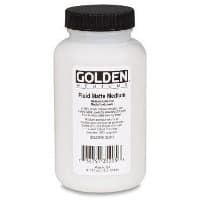 image ©
image © 





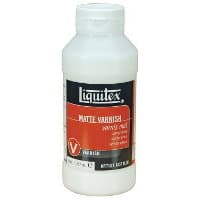 image ©
image ©  image ©
image © 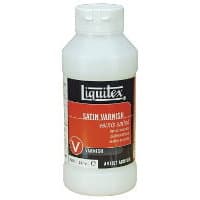 image ©
image © 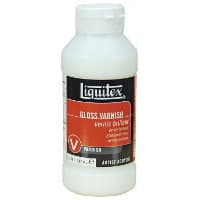 image ©
image © 



Comments powered by CComment